Smartphone thermal imager FLIR ONE
The thermal imager is a device that allows you to see the differences in temperature of objects on the screen. With it, you can detect overheating of wiring and electrical equipment, heat leakage in the house, approximately measure the temperature of objects, including those located far enough.
More recently, thermal imagers were very expensive and prices began at 100,000 rubles. Recently, relatively cheap thermal imagers have begun to appear, but their matrix resolution is very low. For example, the cheapest thermal imagers on Aliexpress cost from $ 240 and have a matrix of only 60 by 60 pixels.
An interesting alternative is thermal imagers for smartphones. They are relatively cheap, with a higher resolution matrix.
I already talked about the thermal imager for the Seek Thermal smartphone, today I will talk about the FLIR ONE thermal imager created by FLIR, which is considered the recognized flagship of thermal imaging technology.
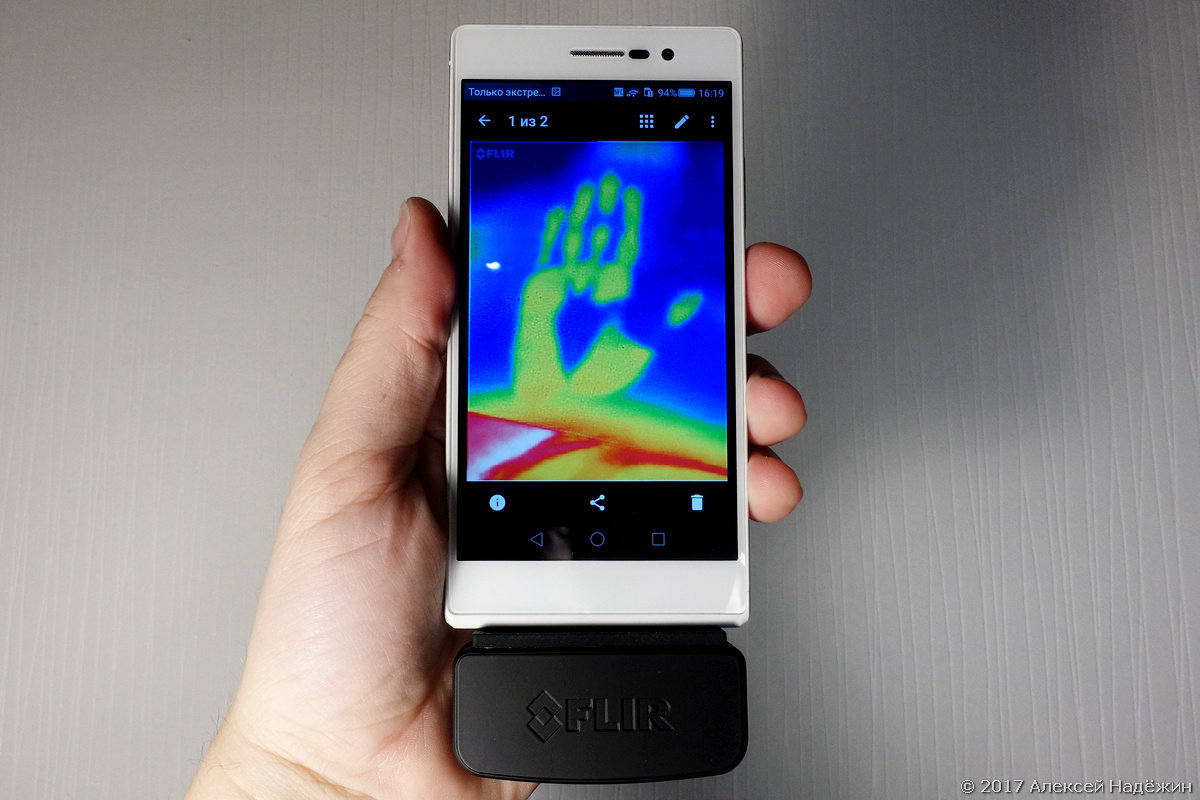
The main feature of FLIR ONE is the presence of two cameras - thermal and conventional, the image from which is combined and the picture becomes more detailed.

This is the second generation of FLIR ONE. The thermal imaging matrix has a resolution of 160x120 pixels (the first generation FLIR ONE had 80x60), and the camera matrix has 640x480 pixels.
The thermal imager has a built-in battery, which allows it to work for 45 minutes and not consume smartphone battery power.
Two versions are on sale - with Lightning connectors for iPhone and with MicroUSB connector for Android smartphones. Only Android smartphones that have USB OTG support can work with the thermal imager (you can check its presence by plugging a USB flash drive with such a connector into the MicroUSB connector).
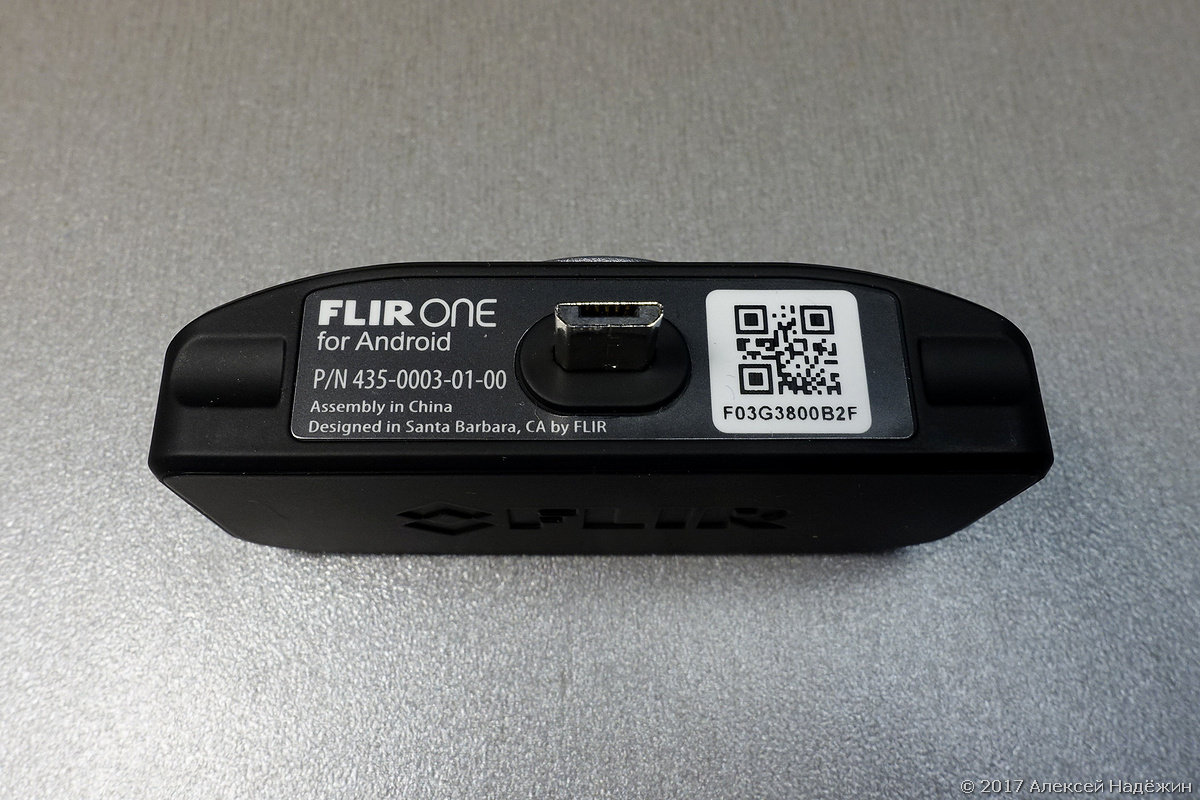
The kit includes a thermal imager, a cover, a belt around the neck, two self-adhesive rubber bands (they can be glued onto the thermal imager from the side of the connector so that the device’s body fits snugly against the smartphone’s body), a very short instruction and an appeal from the head of the company.

On the right side of the case is a MicroUSB connector, which is used to charge the thermal imager and a charging indicator.

On the left side is the power button and a status indicator inside it.
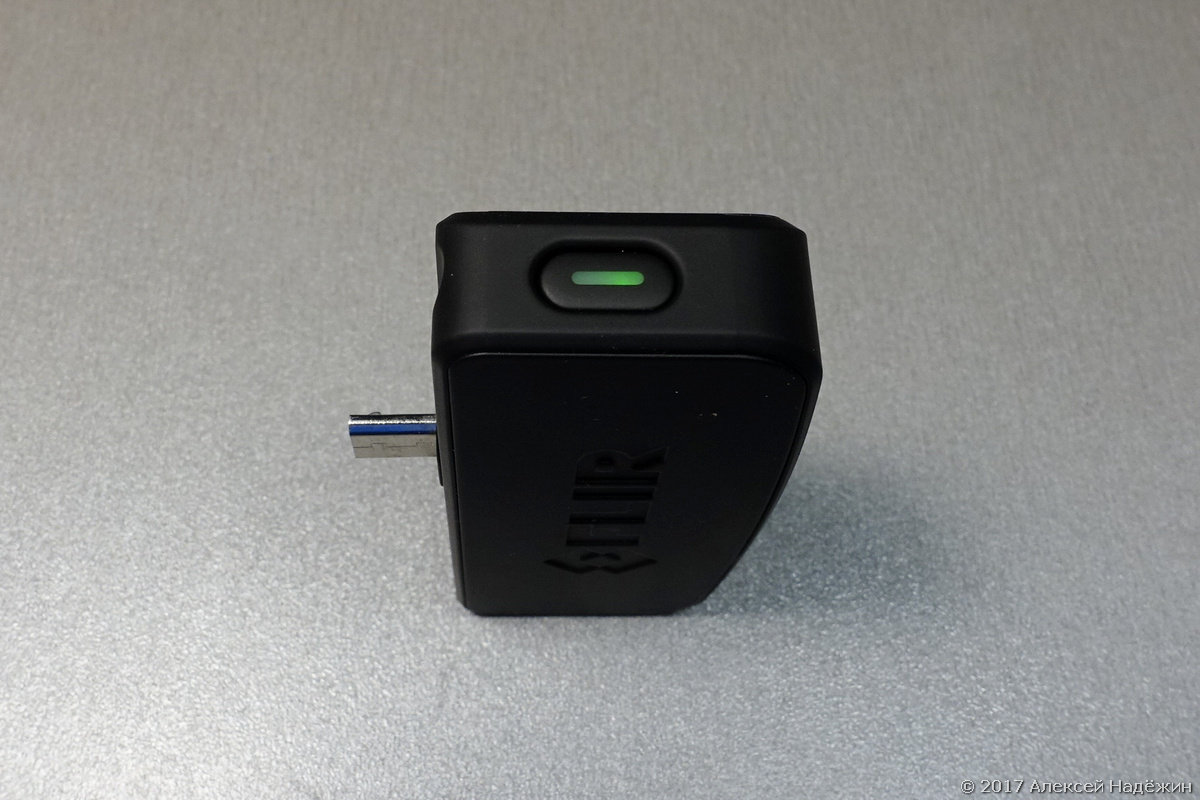
This is how a thin smartphone looks from the side with a connected thermal imager on which a rubber gasket is glued.

Both cameras have a fixed focus that allows you to observe objects located at a distance of 15 cm to infinity. The viewing angle is 46˚ horizontally and 35˚ vertically.
The native FLIR ONE application displays a combined picture.
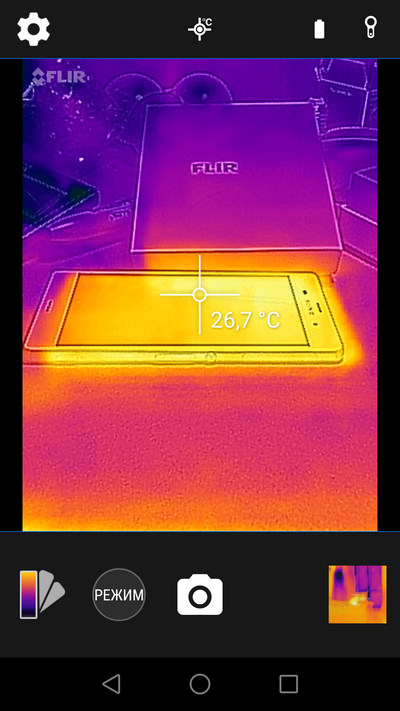
The program continuously displays live thermal imaging video with a refresh rate of about 10 frames per second. About once every 30 seconds the picture freezes (the device is calibrated, this can be turned off).
The application can take photos, videos, time-lapse and even thermal imaging panoramas.
In the application, you can enable the display of temperature, but it is shown only in the center of the image. There is no minimum or maximum. They can be viewed in the same application when viewing a saved image. While viewing saved frames, it is possible to view a picture from a regular camera by swiping your finger down or up. Here you can see that the thermal image is slightly shifted to the side due to the fact that the distance to the object was too small.
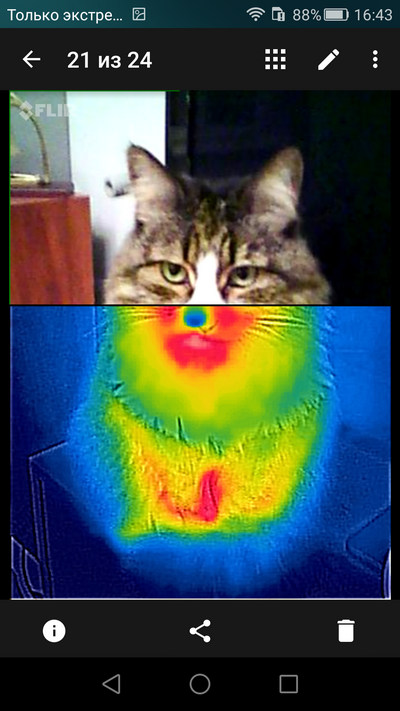
A separate FLIR Tools application, which exists not only for smartphones, but also for Windows and MacOS, can process files stored in the FLIR ONE application. You can see and save only a thermal photograph or only a photograph, you can change the transparency and the algorithm for mixing photos with thermal photographs, it is possible to replace the color palette, apply shapes to the photograph inside which the minimum and maximum temperatures will be displayed.
There is an alternative Thermal Camera application in which there is a simultaneous display of both the temperature in the center and the minimum and maximum temperatures. In the lower right corner, a combined image in the upper part of the screen shows only thermal imaging.

Unfortunately, this application on the Huawei P7 smartphone is unstable, sometimes freezes and crashes.
With the help of a thermal imager you can see a lot of interesting things. For example, if you put your hand on the wall and remove it, a thermal trace will remain on the wall for several minutes.
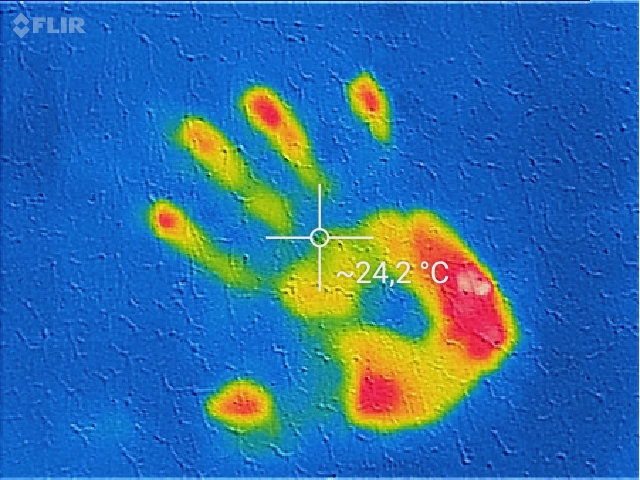
Heat from the battery and cold from poor sealing of the balcony door and window.
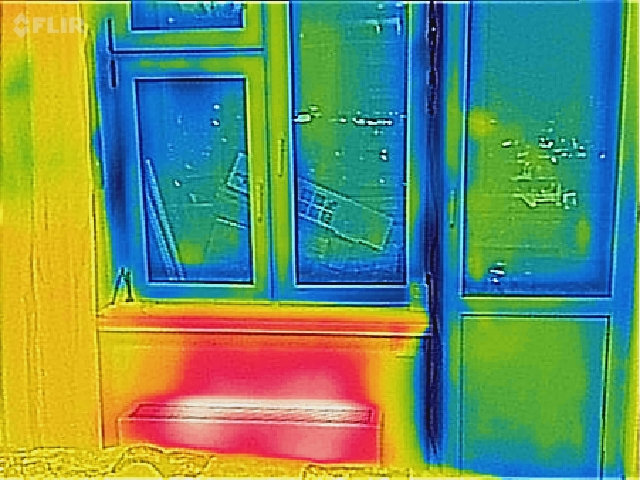
Light.
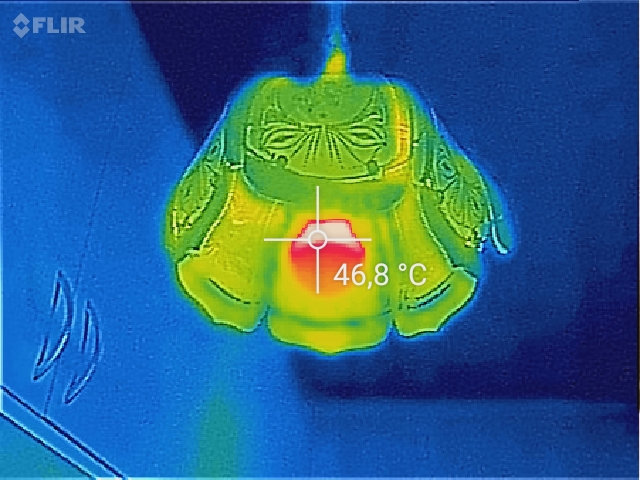
Water pours from the tap. You can immediately see where hot and cold water is supplied.

Thermal selfie.

City view from the balcony. You can clearly see how the heat is leaking.
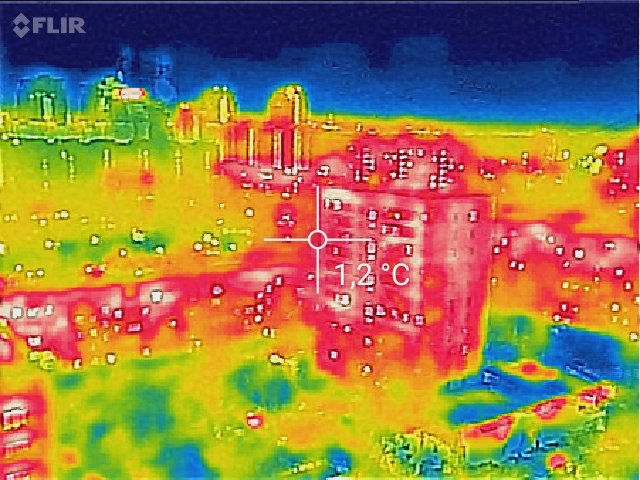
As you know, the coldest point of a cat is its nose.
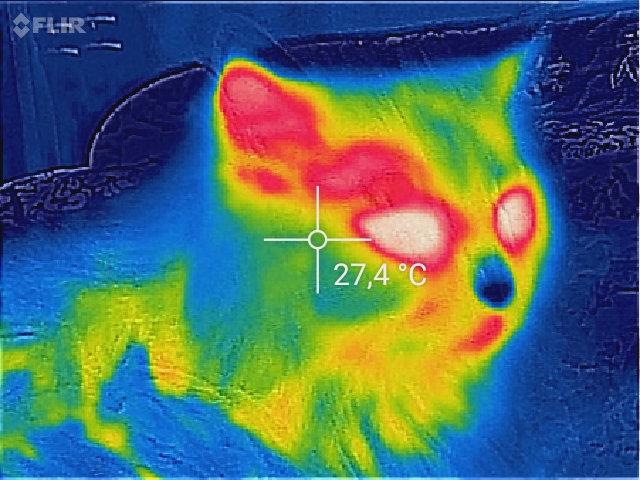
You can even see how warm people’s clothes are by the way they transmit heat.
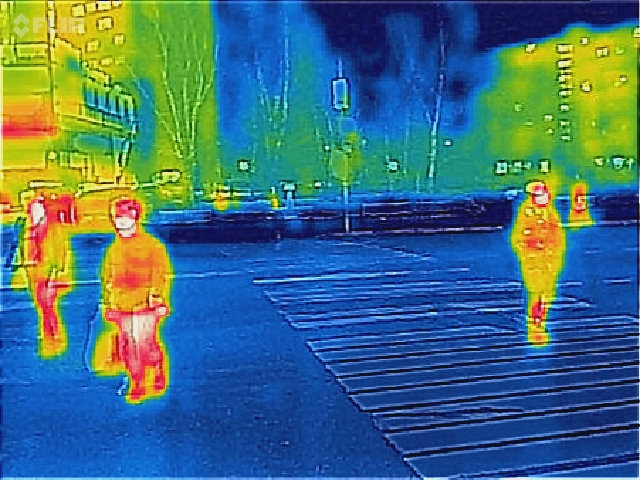
Open vents are clearly visible.

The thermal imager should not be considered as an accurate thermometer. I compared the readings of three thermal imagers - the professional and rather expensive Testo 875, FLIR ONE and Seek Thermal:

As can be seen from the table, the difference in the readings of thermal imagers reaches seven degrees, and it fluctuates in one direction or the other.
FLIR ONE is sold at a price of 21 900 rubles.
A detailed comparison of thermal imagers for a smartphone, read here .
FLIR provided me with the FLIR ONE thermal imager for my lamptest.ru LED lamp test project. With the help of a thermal imager, I will analyze the heating of the lamps and measure the maximum temperature of their housings.
© 2017, Alexey Nadezhin
More recently, thermal imagers were very expensive and prices began at 100,000 rubles. Recently, relatively cheap thermal imagers have begun to appear, but their matrix resolution is very low. For example, the cheapest thermal imagers on Aliexpress cost from $ 240 and have a matrix of only 60 by 60 pixels.
An interesting alternative is thermal imagers for smartphones. They are relatively cheap, with a higher resolution matrix.
I already talked about the thermal imager for the Seek Thermal smartphone, today I will talk about the FLIR ONE thermal imager created by FLIR, which is considered the recognized flagship of thermal imaging technology.

The main feature of FLIR ONE is the presence of two cameras - thermal and conventional, the image from which is combined and the picture becomes more detailed.

This is the second generation of FLIR ONE. The thermal imaging matrix has a resolution of 160x120 pixels (the first generation FLIR ONE had 80x60), and the camera matrix has 640x480 pixels.
The thermal imager has a built-in battery, which allows it to work for 45 minutes and not consume smartphone battery power.
Two versions are on sale - with Lightning connectors for iPhone and with MicroUSB connector for Android smartphones. Only Android smartphones that have USB OTG support can work with the thermal imager (you can check its presence by plugging a USB flash drive with such a connector into the MicroUSB connector).

The kit includes a thermal imager, a cover, a belt around the neck, two self-adhesive rubber bands (they can be glued onto the thermal imager from the side of the connector so that the device’s body fits snugly against the smartphone’s body), a very short instruction and an appeal from the head of the company.

On the right side of the case is a MicroUSB connector, which is used to charge the thermal imager and a charging indicator.

On the left side is the power button and a status indicator inside it.

This is how a thin smartphone looks from the side with a connected thermal imager on which a rubber gasket is glued.

Both cameras have a fixed focus that allows you to observe objects located at a distance of 15 cm to infinity. The viewing angle is 46˚ horizontally and 35˚ vertically.
The native FLIR ONE application displays a combined picture.

The program continuously displays live thermal imaging video with a refresh rate of about 10 frames per second. About once every 30 seconds the picture freezes (the device is calibrated, this can be turned off).
The application can take photos, videos, time-lapse and even thermal imaging panoramas.
In the application, you can enable the display of temperature, but it is shown only in the center of the image. There is no minimum or maximum. They can be viewed in the same application when viewing a saved image. While viewing saved frames, it is possible to view a picture from a regular camera by swiping your finger down or up. Here you can see that the thermal image is slightly shifted to the side due to the fact that the distance to the object was too small.

A separate FLIR Tools application, which exists not only for smartphones, but also for Windows and MacOS, can process files stored in the FLIR ONE application. You can see and save only a thermal photograph or only a photograph, you can change the transparency and the algorithm for mixing photos with thermal photographs, it is possible to replace the color palette, apply shapes to the photograph inside which the minimum and maximum temperatures will be displayed.
There is an alternative Thermal Camera application in which there is a simultaneous display of both the temperature in the center and the minimum and maximum temperatures. In the lower right corner, a combined image in the upper part of the screen shows only thermal imaging.

Unfortunately, this application on the Huawei P7 smartphone is unstable, sometimes freezes and crashes.
With the help of a thermal imager you can see a lot of interesting things. For example, if you put your hand on the wall and remove it, a thermal trace will remain on the wall for several minutes.

Heat from the battery and cold from poor sealing of the balcony door and window.

Light.

Water pours from the tap. You can immediately see where hot and cold water is supplied.

Thermal selfie.

City view from the balcony. You can clearly see how the heat is leaking.

As you know, the coldest point of a cat is its nose.

You can even see how warm people’s clothes are by the way they transmit heat.

Open vents are clearly visible.

The thermal imager should not be considered as an accurate thermometer. I compared the readings of three thermal imagers - the professional and rather expensive Testo 875, FLIR ONE and Seek Thermal:

As can be seen from the table, the difference in the readings of thermal imagers reaches seven degrees, and it fluctuates in one direction or the other.
FLIR ONE is sold at a price of 21 900 rubles.
A detailed comparison of thermal imagers for a smartphone, read here .
FLIR provided me with the FLIR ONE thermal imager for my lamptest.ru LED lamp test project. With the help of a thermal imager, I will analyze the heating of the lamps and measure the maximum temperature of their housings.
© 2017, Alexey Nadezhin
